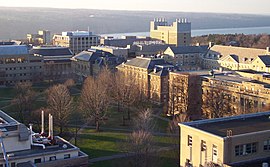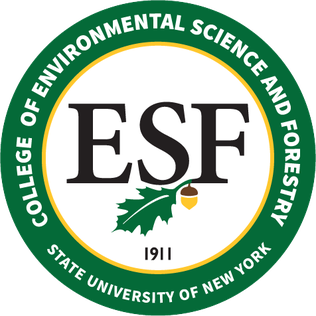
The State University of New York College of Environmental Science and Forestry (ESF) is a public research university in Syracuse, New York focused on the environment and natural resources. It is part of the State University of New York (SUNY) system. ESF is immediately adjacent to Syracuse University, within which it was founded, and with which it maintains a special relationship. It is classified among "R2: Doctoral Universities – High research activity".

The New York State College of Human Ecologyat Cornell University (HumEc) is a statutory college and one of four New York State contract colleges located on the Cornell University campus in Ithaca, New York. The College of Human Ecology is compilation of study areas such as design, design thinking, consumer science, nutrition, health economics, public policy, human development and textiles, each through the perspective of human ecology.

The College of Arts and Sciences is a division of Cornell University. It has been part of the university since its founding, although its name has changed over time. It grants bachelor's degrees, and masters and doctorates through affiliation with the Cornell University Graduate School. Its major academic buildings are located on the Arts Quad and include some of the university's oldest buildings. The college offers courses in many fields of study and is the largest college at Cornell by undergraduate enrollment.
The New York State Agricultural Experiment Station (NYSAES) at Geneva, Ontario County, New York State, is an agricultural experiment station operated by the New York State College of Agriculture and Life Sciences at Cornell University. In August 2018, the station was rebranded as Cornell AgriTech, but its official name remains unchanged.

The history of Cornell University begins when its two founders, Andrew Dickson White of Syracuse and Ezra Cornell of Ithaca, met in the New York State Senate in January 1864. Together, they established Cornell University in Ithaca, New York, in 1865. The university was initially funded by Ezra Cornell's $400,000 endowment and by New York's 989,920-acre (4,006.1 km2) allotment of the Morrill Land Grant Act of 1862
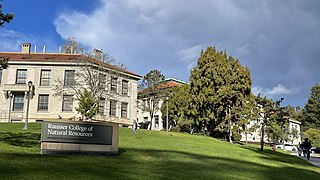
The Rausser College of Natural Resources (RCNR), or Rausser College, is the oldest college at the University of California, Berkeley and in the University of California system. Established in 1868 as the College of Agriculture under the federal Morrill Land-Grant Acts, CNR is the first state-run agricultural experiment station. The college is home to four internationally top-ranked academic departments: Agriculture and Resource Economics; Environmental Science, Policy, and Management; Nutritional Sciences and Toxicology; and Plant and Microbial Biology, and one interdisciplinary program, Energy and Resources Group. Since February 2020, it is named after former dean and distinguished professor emeritus Gordon Rausser after his landmark $50 million naming gift to the college.

Herbert John Webber was an American plant physiologist, professor emeritus of sub-tropical horticulture, first director of the University of California Citrus Experiment Station, and the third curator of the University of California Citrus Variety Collection. Webber was the author of several publications on horticulture, member of numerous professional horticultural and agricultural associations. He coined the word "clone" in 1903 and was the first to use it to describe a colony of organisms derived asexually from a single progenitor.
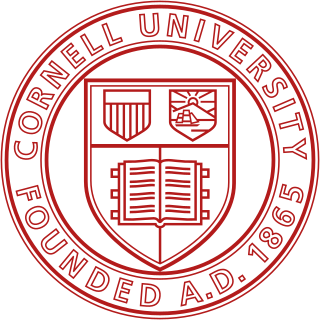
Cornell University is a private Ivy League land-grant research university based in Ithaca, New York. The university was founded in 1865 by Ezra Cornell and Andrew Dickson White. Since its founding, Cornell has been a co-educational and nonsectarian institution. As of fall 2023, the student body included over 16,000 undergraduate and 10,000 graduate students from all 50 U.S. states and 130 countries.

The University of Florida Institute of Food and Agricultural Sciences (UF/IFAS) is a teaching, research and Extension scientific organization focused on agriculture and natural resources. It is a partnership of federal, state, and county governments that includes an Extension office in each of Florida's 67 counties, 12 off-campus research and education centers, five demonstration units, the University of Florida College of Agricultural and Life Sciences, three 4-H camps, portions of the UF College of Veterinary Medicine, the Florida Sea Grant program, the Emerging Pathogens Institute, the UF Water Institute and the UF Genetics Institute.
Daryl Bert Lund is an American food scientist and engineer who has served in various leadership positions within the Institute of Food Technologists, including President in 1990–1991 and editor-in-chief of the Journal of Food Science from 2003-2012. Lund was named one of 26 innovators in Food Engineering magazine's 75th anniversary edition in September 2003.
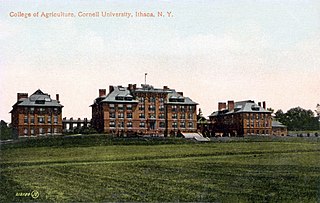
Roberts Hall was the first building of the New York State College of Agriculture at Cornell University, built 1905–1906, and demolished July 1990. A second building of that name was built in 1990.

Stone Hall was a building on the campus of Cornell University in Ithaca, New York, named after John Lemuel Stone, a CALS professor of farm practice during the early 1900s. Stone, Roberts, and East Roberts Hall were three joined buildings on the Agriculture Quadrangle, with the larger Roberts in the center and Stone and East Roberts on the west and east sides, respectively. The three buildings made up the original New York State College of Agriculture, built 1905–1906. The three were demolished in the late 1980s, despite the efforts of the City of Ithaca and local preservationists to save the buildings.

The University of Wisconsin–Madison College of Agricultural and Life Sciences is one of the colleges of the University of Wisconsin–Madison. Founded in 1889, the college has 17 academic departments, 23 undergraduate majors, and 49 graduate programs.
The New York State College of Forestry at Cornell was a statutory college established in 1898 at Cornell University to teach scientific forestry. The first four-year college of forestry in the country, it was defunded by the State of New York in 1903, over controversies involving the college's forestry practices in the Adirondacks. Forestry studies continued at Cornell even after the college's closing.
The New York State College of Forestry, the first professional school of forestry in North America, opened its doors at Cornell University, in Ithaca, New York, in the autumn of 1898., It was advocated for by Governor Frank S. Black, but after just a few years of operation, it was defunded in 1903, by Governor Benjamin B. Odell in response to public outcry over the College's controversial forestry practices in the Adirondacks.

Central Campus is the primary academic and administrative section of Cornell University's Ithaca, New York campus. It is bounded by Libe Slope on the west, Fall Creek on the north, and Cascadilla Creek on the South.
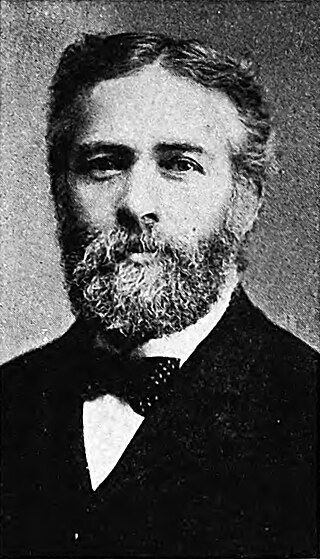
George Chapman Caldwell was an American chemist, horticulturalist, and instructor.

Morrill Hall is a campus building of the University of Vermont (UVM), which is located on the southeast corner of the "University Green" in Burlington, Vermont. The building was named after U.S. Senator, Justin Smith Morrill who authored the Morrill Land-Grant Acts of 1862 and 1890, which created the American Land-Grant universities and colleges. Senator Morrill also served as a trustee of the university from 1865 until 1898. The building was constructed during 1906–07 to serve as the home of the UVM Agriculture Department and the Agricultural Experiment Station. It was added to National Register of Historic Places as part of University Green Historic District on April 14, 1975. As of 2015, the building continues to house the College of Agriculture and Life Sciences and the UVM Agricultural Extension Service.
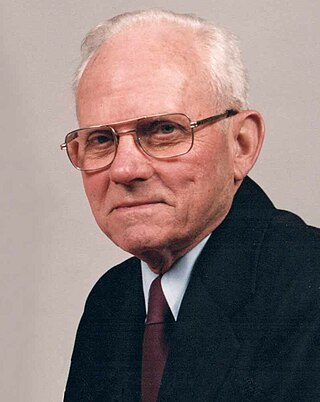
Robert Mumford Smock was an American scientist and a professor at Cornell University. Known for his research for over two decades in the field of controlled atmosphere cold storage, which led to the use of controlled atmosphere rooms in the United States in the 1950s and later throughout the world. The method he developed made it possible to extend the shelf life of fruits, especially apples throughout the year.

Cornell Computing and Information Science is the umbrella name for the information science program at Cornell University, a private university based in Ithaca, New York, United States.
